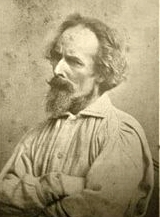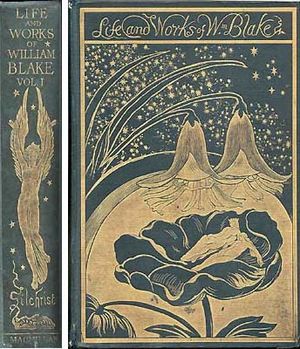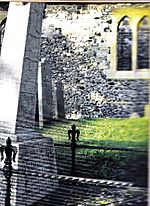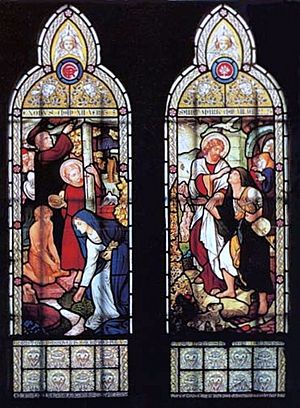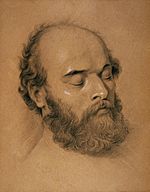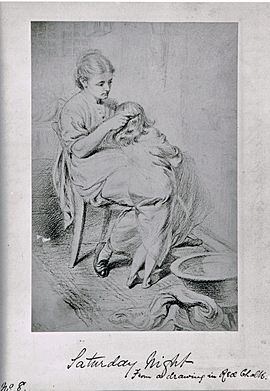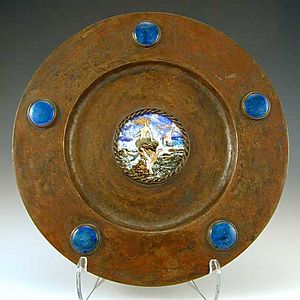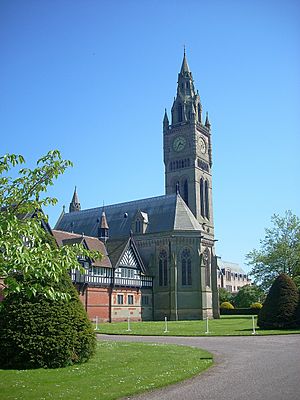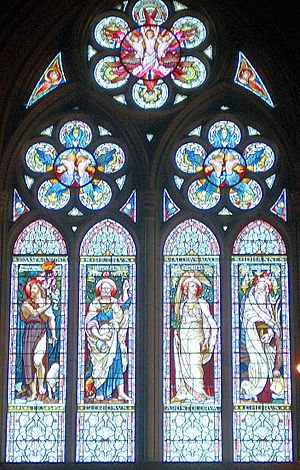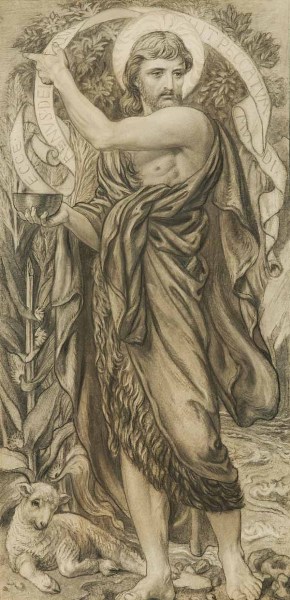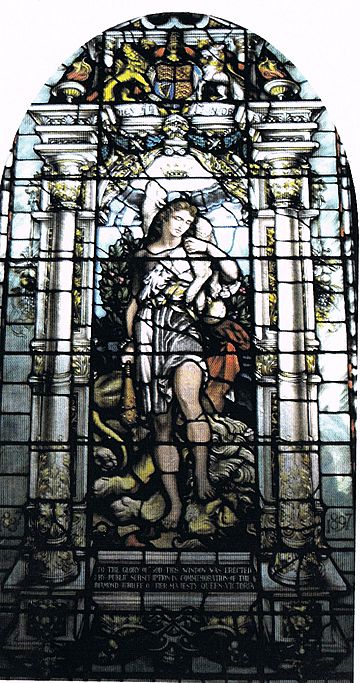Frederic Shields facts for kids
Frederic James Shields (born March 14, 1833 – died February 26, 1911) was a British artist, illustrator, and designer. He was closely connected to the Pre-Raphaelites, a group of artists who wanted to bring back the detailed art of the early Renaissance. He knew famous artists like Dante Gabriel Rossetti and Ford Madox Brown.
Contents
Frederic Shields' Early Life
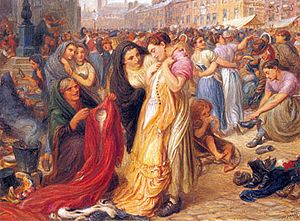
Frederic James Shields was born in Hartlepool on March 14, 1833. He was the oldest of four children. His mother, Georgiana Storey, made straw hats. His father, John Shields, was a bookbinder and printer. He also ran a library. Frederic was baptized Frederick, but he later changed the spelling to Frederic.
In 1839, his family moved to London. Frederic went to St Clement Danes parish school until he was fourteen. His father was a good artist and taught Frederic his first drawing lessons. Frederic also studied engraving in evening classes. He won a drawing prize when he was thirteen. In 1847, he started training with a company that made lithographs. His father's business failed in 1848, and the family moved back north. Frederic joined them there.
He grew up in great poverty. As a young man, he did simple art jobs for companies that made engravings. He managed to study art for a short time in evening classes in London. Then he moved to Manchester around 1848 and continued his studies. He spent much of his life as an artist in Manchester. His drawings and watercolors became well-known there.
Becoming a Book Illustrator
The Manchester Art Treasures Exhibition in 1857 greatly impressed Shields. His art style became more detailed and elegant. He was inspired by a book of poems by Alfred Tennyson, published in 1857 with illustrations. Shields then started working in black-and-white as a book illustrator.
His designs for Daniel Defoe's History of the Plague (1862) and John Bunyan's Pilgrim's Progress (1864) were very popular. These works brought him many fans, including John Ruskin and Dante Gabriel Rossetti. In May 1864, Shields went to London and met Rossetti. Through Rossetti, he soon met all the artists in the Pre-Raphaelite group.
Shields was influenced by Rossetti and Ford Madox Brown. He also admired William Blake, another artist who was important to the Pre-Raphaelites. Shields drew the room where William Blake had died. This drawing even inspired a poem by Rossetti.
Frederic Shields was a very religious man. His strong faith influenced his art. His style slowly became more detailed and focused on spiritual themes. You can see these changes in his most important book design. This was for the second edition of Alexander Gilchrist's Life of William Blake (1880). Rossetti had encouraged him to work on this book. Shields' design for the book's cover is now seen as an early example of the Art Nouveau style.
Life and Art in London
In 1865, Frederic Shields became a member of the Royal Watercolour Society. However, he did not move to London permanently until 1876, after visiting Italy.
He remained very close to the Rossetti family. He often wrote letters to Christina Rossetti. In 1883, after Dante Gabriel Rossetti died, his mother asked Shields to create two stained glass windows. These windows were placed in a small window overlooking Rossetti's grave. The grave is in the churchyard at Birchington, near Margate.
The first window (on the left) uses Rossetti's own design. Shields adapted it from Rossetti's watercolor The Passover in the Holy Family: Gathering Bitter Herbs. The second window was designed by Shields. It shows Christ leading the Blind Man Out of Bethsaida. An inscription below the window remembers Dante Gabriel Rossetti.
After Rossetti's death, his family asked Shields to draw his face. Shields did this drawing, even though he felt sad. He made two copies for Christina Rossetti and another friend.
Shields also became a very close friend with the artist Emily Gertrude Thomson. They worked together on a stained glass project called The Britomart Window. This window was for the Cheltenham Ladies' College. It was based on six pictures from Spenser's story The Faerie Queene. Emily Gertrude Thomson painted a portrait of Frederic Shields. She often visited him when he retired to Merton in Surrey.
Shields created many chalk drawings. In 1864, he started using a special French "compressed charcoal." He showed this material to Rossetti, who then used it for all his larger studies.
Shields also designed three-dimensional art objects. Several items designed and painted by him are known today.
Shields wanted to work on bigger art projects with spiritual themes. In 1879, he and Ford Madox Brown were asked to paint murals for the Manchester Town Hall. These murals showed the history of Manchester. Shields later decided to withdraw from the project. This left Brown to complete all twelve works. However, Madox Brown included Shields in one of the Manchester Murals. He used Shields as the model for John Wycliffe in the fresco called The Reformer's Trial.
Shields' most important works include three series of designs for stained glass and wall paintings. These were for the Chapel of Eaton Hall in Cheshire (1876–1888), a private chapel in Kilmarnock (1877–1879), St Elisabeth's Church, Reddish, Stockport (1881–1883), and finally the Chapel of the Ascension in London (1888–1910).
Major Art Projects and Legacy
Eaton Hall Chapel, Cheshire
Eaton Hall in Cheshire was designed by Alfred Waterhouse. It was built in 1873–1874 for Hugh Lupus Grosvenor, 1st Duke of Westminster. From 1876 to 1888, Shields created designs for its chapel. These designs were for stained glass and stone mosaics. The theme was 'Te Deum Laudamus', which means 'We Praise You, God'.
This large project helped Shields to clearly express his ideas about how art could serve faith. He created nearly ninety subjects that were all connected. They aimed to inspire people with the praise of God and Jesus Christ. This praise came from the lives of apostles, prophets, martyrs, and the Church throughout history.
This work made him famous around the world. An American magazine, The Atlantic Monthly, praised it in 1882. They said Shields showed great power in explaining spiritual life through art. The New York Times also commented on his Eaton Hall designs in 1884. They noted that Shields rose from making simple prints to becoming a leading religious painter in England.
Kilmarnock and Reddish Chapels
Between 1877 and 1879, Frederic Shields created designs for a theme called "The Triumph of Faith." These were meant to decorate the private chapel of William Houldsworth. He was an industrialist and mill-owner. Houldsworth was born in Manchester but lived in Kilmarnock, Scotland. Shields finished the design drawings in 1878–1879.
However, the idea of using Shields' designs at the Kilmarnock chapel was later dropped. A few years later, the designs were changed and used again. This time, they were for St Elisabeth's Church, Reddish, Stockport. William Houldsworth had asked Alfred Waterhouse to design this church. The church was built in a Neo-Gothic style between 1881 and 1883. The decorative plan for this church was much bigger. Shields' drawings were used for the stained-glass windows.
The original drawings themselves were bought from Frederic Shields by Henry Steinthal Gibbs. He was a cotton manufacturer from Manchester. These drawings are now kept at the Manchester Art Gallery.
The Chapel of the Ascension, London
Shields' strong religious feelings were shown even more clearly in his last big project. This was a series of wall paintings he created from 1888 to 1910. They were for the Chapel of the Ascension in Bayswater Road, London.
The Chapel was commissioned by Emelia Russell Gurney. She was the widow of a judge and politician named Russell Gurney. The initial idea was for a small, decorated hall inspired by Italian Renaissance art. A young architect, Herbert Percy Horne, was to build the chapel. Frederic Shields was to decorate it. Shields' strong religious beliefs and artistic ideas greatly shaped the final plan. He wanted the chapel to be a pure, spiritual place.
Mrs. Russell Gurney suggested that Shields and Horne travel to Northern Italy. They went in the autumn of 1889. They visited cities like Milan, Pisa, Florence, and Rome. They studied examples of Renaissance architecture and decoration.
As a result, Shields created a complex plan for the chapel's art. It mixed Bible stories with more symbolic ideas. He wrote to G. F. Watts that his plan included prophets, apostles, Christian virtues, worldly vices, and stories from the Gospels.
For the Chapel of the Ascension, Shields reused some images of prophets and apostles. He had designed these earlier for the Eaton Chapel. But at the Chapel of the Ascension, what had been stained glass and stone mosaics at Eaton Chapel became oil paintings on canvas.
The way Horne and Shields combined decorative art and architecture was greatly admired. A younger artist named Frank Brangwyn later described Shields' decorations. He said they were "the most complete examples of decoration done in England."
Sadly, the Chapel of the Ascension was badly damaged during the Second World War. Shields' mosaics and paintings were destroyed. However, his original designs survived. Frank Brangwyn saved them in the late 1940s. He gave them to several museums in England, including Wolverhampton Art Gallery and William Morris Gallery.
St Ann's Church, Manchester
Among his other important projects, Shields designed the windows in the Chancel of St Ann's Church, Manchester. He created a complete plan for the church's stained glass. The main theme was a Shepherd.
The east windows behind the altar and the windows in the north and south aisles all have this theme. They were made by the company Heaton, Butler and Bayne. The north aisle window was put in to celebrate the Diamond Jubilee of Queen Victoria. After a bomb attack in Manchester in 1996, the window was repaired. It was then dedicated to the memory of Maria Isabella Blythe.
The inscription below the south aisle window says it was dedicated at the Coronation of King Edward VII in 1902.
Frederic Shields' Personal Life
On August 15, 1874, in Manchester, Shields married Matilda Booth (born 1856). She was known as Cissy and had been his model. Shields was 41 and Cissy was 18. Her family and Shields' friends were worried about their age difference. The marriage was quite surprising to many.
Shields soon left for a trip to Europe. In 1875, he left his young wife at a boarding school in Brighton. He had often visited their previous school, Winnington Hall, with other Pre-Raphaelite artists.
Matilda's younger sister, Jessie (born 1870), was adopted by the Shields family soon after their marriage. She was sent to school for several years. The marriage between Frederic and Matilda was not successful. They did not have children and often lived apart. Cissy eventually left him in 1891.
Frederic Shields died on February 26, 1911, in Merton, Surrey. He left some money to Cissy each year. However, most of his money went to missionary societies. He was buried in Merton Old Church, Merton, London SW19.
Literature
- Ernestine Mills. The Life and Letters of Frederic Shields. 1912.The Life and Letters of Frederic Shields at Internet Archive
- Frederic Shields. The Chapel of the Ascension##. 1907.
- Frederic Shields Collection. General Collection, Beinecke Rare Book and Manuscript Library.
- Susan W. Thomson, Manchester's Victorian Art Scene And Its Unrecognised Artists, Manchester Art Press, Warrington, 2007. ISBN: 978-0-9554619-0-3 Chapter 11, Frederic J Shields – 1833–1911, p.p. 120–144.


